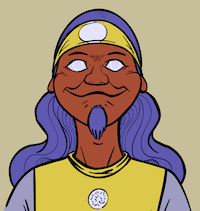In this retrospective, Mr. Vekyl is searching his inner self trying to unravel a mystery on why exactly he turned perfectly good session into a mediocre one.
Yesterday was the tenth session of our group’s RPG, a campaign about far-flung space explorers in the world of Monte Cook’s Numenera. If I was to ask my players if they enjoyed yesterday’s session, I’m positive I’d get lots of great feedback - “You’re a great GM,” “It was a lot of fun!” Personally, though? I ran the session into the ground, and I’m not sure why I did it. Let me explain.
Earlier in the campaign, I anticipated that my group would want to head to the nearby forest to mount a rescue mission for one of their missing crew members. During my prep, I built up a few towns and made sure there were interesting things to do in each of them. The one they ended up heading towards was a place called Larnwick, a small forest trade town, with the predominant feature being a large greenhouse on the outer edge.
I knew I wanted something special to go on in this greenhouse, so I built out a murder mystery - a brilliant botanist obsessesed with carnivorous plants, who gets killed by some of his own creations. There was even a coded journal to find, full of clues about how the greenhouse worked, about his secret lab in the basement, and about the creatures themselves.
What happened when the players first discovered this greenhouse and the dead botanist? First, they robbed him, including the coded journal. “We aren’t the Scooby Doo gang,” they then declared, “and we still need to rescue our friend.” Off into the forest they went, ignoring the content completely. I was fine with this - after all, if the players didn’t engage with the content, the content would move on without them. I made some notes about what would happen over the next few days because the mystery was left unsolved, and continued with the campaign. One of the characters decoded the journal, but kept the information to herself for the next couple days.
A few days later, their rescue mission a success, the players reemerged from the forest at Larnwick and discovered some troubling news. Something was killing animals on nearby farms, and the tracks led right back to that greenhouse. This time, the hook sunk in, and they prepared to investigate. Right as they approached the structure, they heard a scream from within. Rushing inside, they found one of the townspeople bloody and injured. They stabilized her and pulled her out, and during the rescue a PC was attacked by one of the carnivorous plants that had killed the botanist. They fought it off and quickly escaped.
At this point, the group made the choice to investigate further, while an NPC companion would take the victim back to town and look for help. Reciting the contents of the decoded journal, they learned that the greenhouse had a secret lab somewhere, that it was possible to create a paralytic agent to incapacitate the creatures, and that the greenhouse had environmental controls that they could use against the carnivorous plants. Everything I’d prepped ages ago was paying off! They were engaging with my cool content, and I was thrilled they were going to see all the weird things I built out for them.
Here’s how I figured it would go down:
- The players would head to the non-secret lab on the second floor to try to replicate the paralytic agent.
- They would search for the entrance to the secret lab, and discover the locking mechanism (a razor sharp crystal flower that can be keyed to a specific person’s blood).
- Needing the blood of the greenhouse owner, they’d have to find a sample of his blood, including the possibility of digging up his recently buried body.
- At some point before entering the secret lab, they would be ambushed by the 3 juvenile carnivorous flowers.
- After entering the secret lab, they would explore and discover two “sleeping” adult carnivorous flowers, and have several options:
- Fight the creatures head on
- Use or create more paralytic agent to use on them
- Sneak around them and try to manipulate the environmental controls
- Something completely different I hadn’t thought of
- The NPC companion would return at an appropriate time with reinforcements.

And here’s how it actually went down:
- The players headed to the non-secret lab on the second floor and successfully replicated the paralytic agent.
- They searched for the entrance to the secret lab, and discovered the locking mechanism (a razor sharp crystal flower that can be keyed to a specific person’s blood).
-
The players were ambushed by the three juvenile carnivorous plants.
So far so good. But then, I did something supremely stupid:
-
An injured juvenile plant screeched in pain, waking up the sleeping adults, who left the basement and joined the fight.
- The NPC companion showed up with reinforcements.
In the moment, it felt like a natural thing to happen - the juvenile plant had just been split open, was bleeding heavily, and cried out for help. But this improvised reaction, in retrospect, took a lot of the wind out of what could have been a much better session.
- Breaking up the combat by switching gears to the puzzle of the door lock? Gone.
- Letting my players figure out how the blood flower worked? Nope.
- Watching them struggle with the conundrum of digging up the botanist’s body for a sample of his blood? Nah.
- Setting up a tense atmosphere as they explored a secret lab? Not today.
- Letting the players deal with the adult creatures in any way they saw fit (which would have certainly not included direct combat), taking advantage of all the clues and the unique trappings of the greenhouse? Too bad, it’s combat time.
By having the adults leave their den and join in on an already long fight (with 5 players, combat rounds take a while), the entire session became one big 2-hour combat slog. The creatures were successfully subdued and the PCs were hailed as heroes, but I heavily shortchanged both myself and my players by replacing all those cool elements I’d been leading up to with one long combat and removing a number of interesting decisions.
In writing this retrospective, I was hoping to determine why I made such a big mistake. Was I not trusting my players to solve the puzzle themselves? Was I feeling time pressure to “finish” the scenario within the 2 hour time slot? Did I not leave myself enough time before the session started to fully think through the best way to run the scenario?
In the end, I think I just made a mistake, one that shows I still have a lot to learn as a GM. I made an improvised decision that made logical sense in the moment, without thinking about how that decision would impact the session as a whole. It’s a lesson well learned, and one I hope to not make again. Next time, I won’t shortchange my players, myself, and the story. Next time, they’re going to solve the puzzle, explore the dungeon, and beat the big bads any way they see fit.
Next time…well, we’ll just see what happens next time.


Comments